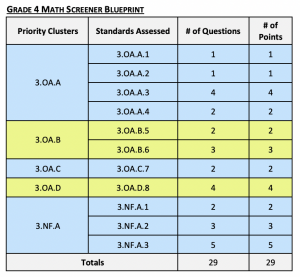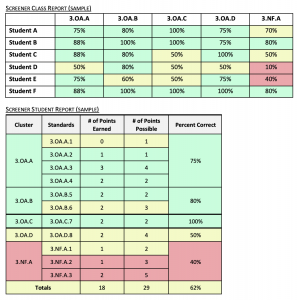Using the Data to Inform Instruction
The mathematics screeners are meant to provide information about student strengths and areas of improvement regarding how well students can solve problems in mathematics aligned to the most important college- and career-ready standards at each grade level. The score reports provide useful data, such as the number of points earned out of the number of points possible and the standard alignment which can be used to help inform instructional decisions and deepen educators’ understanding of their students’ learning progress toward college and career readiness.
When analyzing score reports, consider the percent earned by cluster and/or standard; however, be careful when considering standard level data especially if there are few questions aligned to that standard. For example, consider a student that incorrectly answers a question aligned to 3.OA.A.1 on the Grade 4 screener. As noted in the blueprint below, there is only 1 question aligned to that standard, so it would be better to consider how the student performed on the 3.OA.A cluster to help determine next steps and not jump to the immediate conclusion that support is needed with that standard.

Analyzing Score Reports
The score reports will depend on the platform for which students are taking the assessment. The screeners were designed so that the score reports would inform student proficiency on the most critical content from the previous grade, including the student percentage on the overall assessment, as well as achievement at the standard and cluster levels. See the sample reports below. Class and student reports should show student performance on each cluster and standard assessed. Note that reports will vary depending on the platform that the school utilizes.

Guidance when Analyzing Reports
The chart below provides general guidance when analyzing score reports and determining if support is needed to help students shore up misunderstandings and skill deficiencies. The percent earned should be considered for each cluster assessed and for standards assessed with 4 or more questions.

Paths to Consider
- For students needing support, consider reviewing the student’s “Show Work” paper to investigate and un-cover misunderstandings and other errors.
- CenterPoint created Blueprint documents that include information about learning progressions which should be considered when preparing to teach certain topics. For example, if you have a 4th grade student that takes the screener, and the results indicate that the student needs support in cluster 3.NF.A, then you might consider one of two things:
- Review the Blueprint documents to understand the learning progressions.
- Use the Achieve the Core map to understand the learning progressions.
Both options will help you determine when to provide support for students regarding 3.NF.A content. With both options, you’ll want to:
- Determine when the 3.NF.A content is needed within the Grade 4 curriculum.
- Determine other grade 3 standards and prior grade level standards that are connected to the 3.NF.A standards as students might need support in those areas.
- Provide support on the 3.NF.A standards and possibly the prior grade level standards in conjunction with the connected 4th grade standards.
- Depending on the level of support needed, additional time may be required to help students “catch up” in their areas of need. In cases as such, we suggest working with school leaders to think creatively about structures that allow such time for students to strengthen their math skills and understandings.
Strategies for Supporting Students in Mathematics
To support increased learning in mathematics:
- Have students describe his/her thinking as they solve math problems. Math problems can come from the screener, school curriculum, released items from the state summative assessment, or other open resources that are well-known for producing quality content. A list of resources at the end of this document may be of help. Since students may be unfamiliar with how to think aloud, teachers will likely want to model the process with a sample question. The act of listening to students as they think aloud is a great means to helping teachers and students uncover conceptual misunderstandings and provide insight into the nature of erroneous thinking.
- Teachers in a professional learning community (whether formal or informal) may find it helpful to share ideas on how to support students who are struggling with mathematics at a given grade level.
- To support the focus of learning on-grade level content, consider how the curriculum allows for embedding additional supports needed within upcoming lessons, thereby allowing for supports to be provided as part of daily core general instruction.
- Work with school leaders to think creatively about structures that allow additional time for students to strengthen their math skills and understandings, especially those needing intensive support.
- Model multiple techniques and approaches to demonstrate different pathways to solving problems.
- Use mathematics manipulatives to help students conceptualize abstract concepts.
- Have students work with others to solve problems.
- Create scaffolded problem sets to chunk the learning.
- Use easier numbers in problem sets to uncover conceptual misunderstandings.
- Share sample math questions with resource teachers and those who teach content other than mathematics, but whose content areas apply mathematics (e.g., science, computer science, technology education, etc.), and share how they can support students who require additional instruction and practice for identified skill gaps.
Math Resources for Students Needing Support
- Illustrative Mathematics provides free access to their library of mathematics curriculum, instructional tasks, and resources including math resources for families.
- Great Minds has launched Knowledge on the Go with written materials for math (K-12) and Eureka Math daily instructional videos (K-8).
- Student Achievement Partners offers high-quality open-source classroom resources, including Math lessons and assessments. Other resources include:
- Khan Academy: Content in Math, Science & Engineering, Arts & Humanities, SAT: free standards-aligned practice and lessons
- Citizen Math: Search by standard or math topic to find math tasks related to real-world challenges. The Citizen Math mission is to make the world a better place by inspiring young people to develop the problem-solving skills they will need to analyze, discuss, and solve the important issues faced by society.